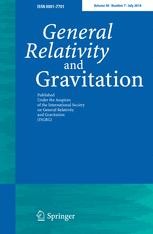GRG Editor's Choice: Light deflection and Gauss–Bonnet theorem: definition of total deflection angle and its applications
 Arakida, H., Light deflection and Gauss–Bonnet theorem: definition of total deflection angle and its applications, Gen Relativ Gravit (2018) 50: 48. https://doi.org/10.1007/s10714-018-2368-2
Arakida, H., Light deflection and Gauss–Bonnet theorem: definition of total deflection angle and its applications, Gen Relativ Gravit (2018) 50: 48. https://doi.org/10.1007/s10714-018-2368-2
Editor's Choice (Research Article)
First Online: 05 April 2018
"The author implements a new approach to study the deflection angle inspired by the Gauss–Bonnet Theorem. The paper is extremely well written in terms of pedagogical approach, stating the assumption and deriving the formula. It is an important contribution to the field and the debate on the impact of the cosmological constant on gravitational lensing."
Abstract:
In this paper, we re-examine the light deflection in the Schwarzschild and the Schwarzschild–de Sitter spacetime. First, supposing a static and spherically symmetric spacetime, we propose the definition of the total deflection angle α of the light ray by constructing a quadrilateral Σ4 on the optical reference geometry Mopt determined by the optical metric gij. On the basis of the definition of the total deflection angle α and the Gauss–Bonnet theorem, we derive two formulas to calculate the total deflection angle α; (1) the angular formula that uses four angles determined on the optical reference geometry Mopt or the curved (r,ϕ) subspace Msub being a slice of constant time t and (2) the integral formula on the optical reference geometry Mopt which is the areal integral of the Gaussian curvature K in the area of a quadrilateral Σ4 and the line integral of the geodesic curvature κg along the curve CΓ. As the curve CΓ, we introduce the unperturbed reference line that is the null geodesic Γ on the background spacetime such as the Minkowski or the de Sitter spacetime, and is obtained by projecting Γ vertically onto the curved (r,ϕ) subspace Msub. We demonstrate that the two formulas give the same total deflection angle α for the Schwarzschild and the Schwarzschild–de Sitter spacetime. In particular, in the Schwarzschild case, the result coincides with Epstein–Shapiro’s formula when the source S and the receiver R of the light ray are located at infinity. In addition, in the Schwarzschild–de Sitter case, there appear order O(Λm) terms in addition to the Schwarzschild-like part, while order O(Λ) terms disappear.
The author:
Hideyoshi Arakida is an Associate Professor at Nihon University, Koriyama, Japan
GRG Editor's Choice:
In each volume of GRG, a few papers are marked as “Editor’s Choice”. The primary criteria is original, high quality research that is of wide interest within the community.
